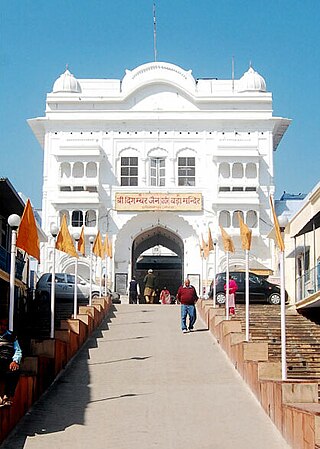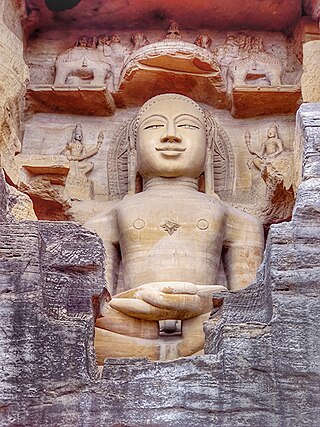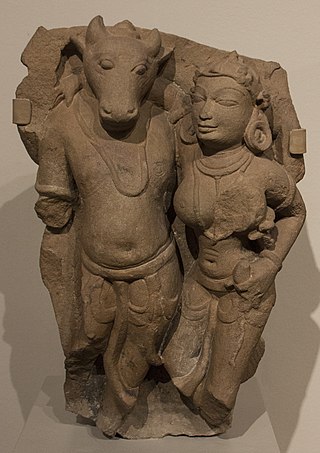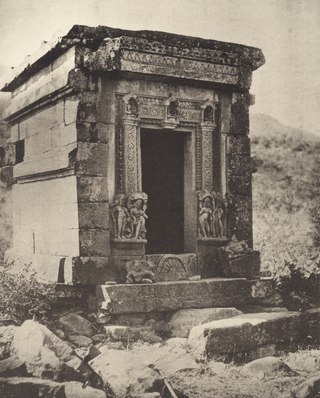
The Dilwara Temples or Delvada Temples are a group of Śvētāmbara Jain temples located about 2+1⁄2 kilometres from the Mount Abu settlement in Sirohi District, Rajasthan's only hill station. The earliest were built by Bhima I and supposedly designed or at least financed by Vastupala, Jain minister of Dholka. They date between the 11th and 16th centuries, forming some of the most famous monuments in the style of Māru-Gurjara architecture, famous for their use of a very pure white marble and intricate marble carvings. They are managed by Seth Shri Kalyanji Anandji Pedhi, Sirohi and are a pilgrimage place for Jains, and a significant general tourist attraction. The Dilwara temples are regarded as the most impressive among Jain temples in Rajasthan.

Shikharji, also known as Sammed or Sammet Shikharji, is one of the Holiest pilgrimage sites for Jains, in Giridih district, Jharkhand. It is located on Parasnath hill, the highest mountain in the state of Jharkhand. It is the most important Jain Tirtha, for it is the place where twenty of the twenty-four Jain tirthankaras along with many other monks attained Moksha. It is one of the five principal pilgrimage destinations along with Girnar, Pawapuri, Champapuri, Dilwara, Palitana and Ashtapad Kailash.

Rishabhanatha, also Ṛṣabhadeva, Rishabhadeva, Ṛṣabha or Ikshvaku is the first Tīrthaṅkara of Jainism and establisher of Ikshvaku dynasty. He was the first of twenty-four teachers in the present half-cycle of time in Jain cosmology, and called a "ford maker" because his teachings helped one cross the sea of interminable rebirths and deaths. The legends depict him as having lived millions of years ago. He was the spiritual successor of Sampratti Bhagwan, the last Tirthankar of previous time cycle. He is also known as Ādinātha which translates into "First (Adi) Lord (nātha)", as well as Adishvara, Yugadideva, Prathamarajeshwara, Ikshvaku and Nabheya. Along with Mahavir Swami, Parshvanath, Neminath, and Shantinath, Rishabhanath is one of the five Tirthankaras that attract the most devotional worship among the Jains.

Saraks is a community in Jharkhand, Bihar, Bengal, and Orissa. They have been followers of some aspects of Jainism, such as vegetarianism, since ancient times, however, were isolated and separated from the main body of the Jain community in western, northern, and southern India and have been Hindu Bengalis ever since. The governments of India and West Bengal both have classified some of the Saraks under Other Backward Classes since 1994 but many of them have been in the General category from the beginning itself.

Jain sculptures or Jain idols are the images depicting Tirthankaras. These images are worshiped by the followers of Jainism. The sculpture can depict any of the twenty-four tirthankaras with images depicting Parshvanatha, Rishabhanatha, or Mahāvīra being more popular. Jain sculptures are an example of Jain art. There is a long history of construction of Jain sculptures. Early examples include Lohanipur Torsos which has been regarded to be from the Maurya period, and images from the Kushan period from Mathura.

Jain art refers to religious works of art associated with Jainism. Even though Jainism has spread only in some parts of India, it has made a significant contribution to Indian art and architecture.

Shri Digamber Jain Prachin Bada Mandir is a Jain temple complex located in Hastinapur, Uttar Pradesh. It is the oldest Jain temple in Hastinapur dedicated to Shri Shantinatha, the 16th Jain Tirthankara.

The Gopachal rock-cut Jain monuments, also called Gopachal Parvat Jaina monuments, are a group of Jain rock-cut carvings dated to between the 7th and 15th centuries. They are located around the walls of the Gwalior Fort, Madhya Pradesh. They depict Tirthankaras in seated Padmasana posture as well as standing Kayotsarga posture, in the typical naked form of Jain iconography.

Bajramath Temple is a Jain temple located in Gyaraspur town of Vidisha in state of Madhya Pradesh, India.
In 1956, 240 Jain bronze idols were discovered dating back to early medieval to medieval period. The Vasantgarh hoard, thus named after the place of discovery, Vasantgarh is located in the Sirohi District of Rajasthan, India.

In Jain cosmology, Gomukha is the guardian god or Yaksha of Rishabhanatha, the first Tirthankara.
Pakbirra is a village in the Puncha CD block in the Manbazar subdivision of the Purulia district in the state of West Bengal, India.
Suisa is a village in the Tunturi-Suisa panchayat in the Baghmundi CD block in the Jhalda subdivision of the Purulia district in the state of West Bengal, India.
Deulghata, near Baram in the Arsha in the Purulia Sadar subdivision of the Purulia district of West Bengal, India, has ancient/ medieval temples.
Budhpur is a village in the Manbazar I CD block in the Manbazar subdivision of the Purulia district in the state of West Bengal, India.

The Kumbharia Jain temples is a group of five Jain temples in the Kumbhariya, Banaskantha district in Gujarat, India. Constructed from 1062 to 1231 CE during the reign of the Chaulukya dynasty, they are noted for their elaborate architecture.

The Ahichchhatra Jain temples is a group of Jain temples in Ahichchhatra village in Aonla tehsil of Bareilly district in Uttar Pradesh, North India. Ahichchhatra is believed to be the place where Parshvanatha, the 23rd Tirthankar of Jainism, attained Kevala Jnana.

Pataini temple or Pataini devi temple is a 5th century Jain temple located near Unchehara town in the state of Madhya Pradesh. The temple was constructed during the reign of Gupta Empire.

Chaturmukha Basadi is a symmetrical Jain temple located in Gerusoppa in Honnavar Taluk of Uttara Kannada district in the Indian state of Karnataka. The temple is situated near the banks of the Sharavati.

Danavulapadu Jain temple is an ancient Jain center located in Danavulapadu village of Kadapa district in the state of Andhra Pradesh.




















